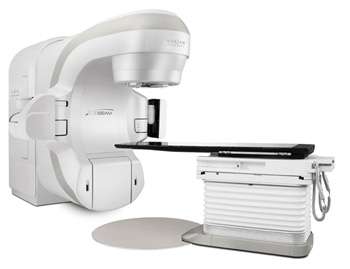Frequently Asked Questions
Find your care
Radiation oncologists use a patient-centered approach and individualized treatment plans. To learn more and make an appointment with a UCLA radiation oncologist, contact us at:
Westwood - 310-825-9775
Santa Clarita - 661-287-0010
Santa Monica - 424-259-8777
Frequently Asked Questions - TrueBeam System at UCLA
What is the Varian TrueBeam system?
The TrueBeam ™ system is an advanced radiotherapy system from Varian Medical Systems. It was engineered from the ground up to deliver more powerful cancer treatments with pinpoint accuracy and precision. It uniquely integrates advanced imaging and motion management technologies within a sophisticated new architecture that makes it possible to deliver treatments more quickly while monitoring and compensating for tumor motion, opening the door to new possibilities for the treatment of lung, breast, prostate, head and neck, as well as other cancers.

Why would a patient want to be treated with Varian TrueBeam?
A doctor may prescribe treatment with the TrueBeam system for many reasons. This technology gives medical professionals the tools to treat many different types of cancers. Also, TrueBeam is fast. Simple treatments that once took 10 to 30 minutes can now be completed in less than two minutes. As well as allowing for a more comfortable experience for the patient with less time on the treatment couch, faster delivery also allows for reduced chances of tumor motion during treatment, which helps protect nearby healthy tissue and critical organs.
The precision of the TrueBeam system is measured in increments of less than a millimeter. This accuracy is made possible by the system’s sophisticated architecture, which synchronizes imaging, patient positioning, motion management, beam shaping and dose delivery, performing accuracy checks every ten milliseconds throughout the entire treatment. TrueBeam imaging technology can produce the three-dimensional images used to fine-tune tumor targeting in 60% less time than previous Varian imaging technology. Additional functionality makes it possible to create images using 25% less X-ray dose. These images are used to fine-tune a patient’s position prior to and during the treatment process.
For lung and other tumors subject to respiratory motion, TrueBeam offers Gated RapidArc ® radiotherapy, which makes it possible to monitor the patient’s breathing and compensate for movement of the tumor while the dose is being delivered in a continuous rotation of the treatment machine. In addition to its impressive technical specifications, TrueBeam has also been designed with patient comfort in mind. It operates quietly and provides built-in music capabilities so the patient can listen to music during their treatment. The patient is in constant two-way communication with the therapist who operates the system. Plus the therapist will be able to visually monitor and see the patient through two closed-circuit television systems.
Does a person become radioactive after treatment?
External radiation therapy does not cause anyone’s body to become radioactive. A patient need not avoid being with other people because of treatment. Even hugging, kissing or having sexual relations with others poses no risk to them of radiation exposure.
Side effects of radiation therapy most often are related to the area that is being treated. A patient should consult with their medical professional to discuss the specific diagnosis, prognosis and possible side effects** from radiation treatment.
Is a TrueBeam treatment expensive?
The exact cost of radiation therapy will depend on the type and number of treatments a patient needs. Many health insurance policies cover charges for radiotherapy. It's a good idea for a patient to talk with their insurer or with their doctor's office staff or the hospital business office about their policy and how expected costs will be paid.
What is unique about treatment using Varian’s TrueBeam technology?
The main advantages of the Varian TrueBeam system are ease, precision and speed. Thanks to its pinpoint accuracy, the TrueBeam system can be used to treat many different types of tumors, including those in sensitive areas such as the abdomen, liver, lung, breast, and head and neck. Treatments focus powerful radiation on the tumor while minimizing exposure of surrounding healthy tissues. TrueBeam was designed from the ground up to seamlessly integrate sophisticated imaging and radiation delivery treatments. What this means for patients is accuracy, speed and comfort. What it means for medical professionals is the ability to treat many different types of complex cancer cases.
** The TrueBeam system may not be appropriate for all cancers. Serious side effects can occur, including fatigue and skin irritation. Treatment times may vary. Patients should ask their doctor if TrueBeam is right for their particular case.